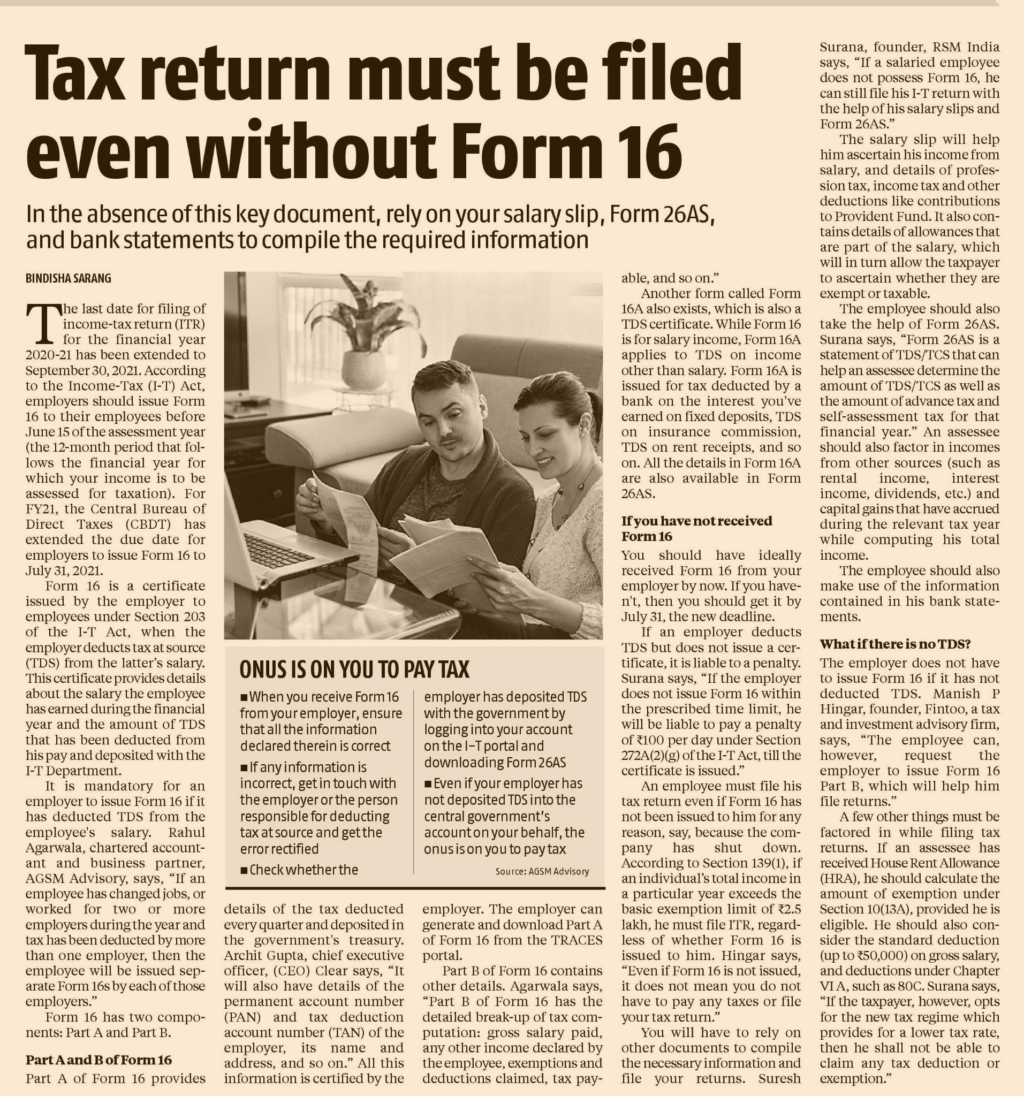How to file Income Tax Return without having received form 16 and what are limitations

Filing Income Tax Return without form 16
Filing an income tax return without Form 16 can be a bit more challenging, but it is still possible. Form 16 is a document provided by your employer that summarizes your income, deductions, and tax withheld during the financial year. However, if you haven’t received Form 16, you can follow these steps to file your income tax return:
Gather all relevant documents:
Start by collecting all the necessary documents to accurately calculate your income and deductions. These may include salary slips, bank statements, rent receipts (if applicable), investment proofs, and any other supporting documents related to your income and expenses.
Determine your income sources:
Identify all the sources of your income for the financial year. This can include salary, interest income, rental income, freelance income, or any other sources of revenue. Make sure you have the necessary documentation to support each source of income.
Be careful to recall each possible income, sometimes even these come as small receipts as Dividends from shares. In case you forget to include the same, you may get the notice from Income Tax Department.
Calculate your income:
Compile the income details from each source and calculate your total income for the financial year. Include any exempted income or income eligible for deductions. Refer to your bank statements, salary slips, and other relevant documents to ensure accuracy.
Verify your Income:
Download from Income Tax Department’s Official website and after logging in, download Form26AS, AIS and TIS Forms. Reconcile the same with the income summary you prepared with the incomes/ Tx=axes deducted as reflected in these forms. In case you have missed out any income appearing in these forms, please do rectify the return you have made. In case, you observe any discrepancy in the figures as being shown in these forms, report such mistake immediately to Income Tax Department through the appropriate link in the portal itself.
Claim deductions:
Identify the deductions applicable to you based on the provisions of the Income Tax Act. Common deductions include contributions to provident fund (PF), Public Provident Fund (PPF), National Pension Scheme (NPS), life insurance premiums, medical insurance premiums, home loan interest, and tuition fees, among others. Ensure you have supporting documents for each deduction claimed.
Compute your tax liability:
Use the income tax slabs and rates applicable for the financial year to compute your tax liability. You can refer to the income tax slab rates available on the official website of the income tax department or consult a tax professional for assistance in calculating your tax liability accurately.
Prepare your tax return:
Visit the official income tax e-filing website, i.e. the Income Tax Department of India’s website and register yourself as a taxpayer if you haven’t done so already. Then, proceed to file your income tax return online by selecting the appropriate form for your income type (e.g., ITR-1, ITR-2, etc.).
Fill in the necessary details:
Provide accurate details in the income tax return form. Include your personal information, income details, deductions claimed, tax payments made, and any other information required in the form. Ensure the information is complete and accurate to the best of your knowledge.
Declare your income and pay self-assessment tax:
In the absence of Form 16, you’ll have to declare your income under the appropriate sections in the income tax return form. If you have any outstanding tax liability, calculate and pay the self-assessment tax using the Challan 280 form available on the income tax department’s website.
Validate and submit your return:
Before submitting your income tax return, validate all the details entered in the form to ensure accuracy. Once you’re confident that everything is correct, submit the form electronically through the e-filing portal. You may be required to digitally sign the return using your Aadhaar card, PAN card, or other designated methods.
Keep a copy for your records:
After successfully filing your income tax return, make sure to download and save a copy of the acknowledgment or ITR-V (Income Tax Return-Verification) for future reference. You may need it for any verification or future communication with the income tax department.
Some Limitations in filing income tax return without form 16
Filing an income tax return without Form 16 in the Indian context can have certain limitations. Some of the limitations include:
Difficulty in calculating accurate income:
Form 16 provides a consolidated view of your salary, allowances, deductions, and tax deducted at source (TDS) by your employer. Without Form 16, you may face challenges in accurately calculating your income and determining the taxable amount.
Lack of proof of TDS:
Form 16 serves as proof that your employer has deducted TDS from your salary. Without this form, you may not have sufficient documentation to support the TDS claimed while filing your income tax return. However, in view of the Tax figure getting reflected in Form26AS, this may not be major trouble any more.
Inability to claim deductions accurately:
Form 16 provides details of deductions such as provident fund (PF) contributions, life insurance premiums, and other exemptions allowed under the Income Tax Act. Without this form, you may struggle to accurately claim these deductions and may not have the necessary supporting documents.
Potential errors in reporting income:
Form 16 helps individuals report their income correctly, as it provides a summarized statement of income and deductions. Without this form, there is a higher risk of errors or omissions while reporting income from different sources, resulting in incorrect tax calculations and potential penalties.
To mitigate these limitations as coming from not having Form16, it is advisable to take the following steps:
- Maintain proper records: Keep a record of your salary slips, bank statements, investment proofs, rent receipts, and other relevant documents to support your income and deductions.
- Calculate income accurately: Take time to calculate your income from various sources diligently. Refer to bank statements, rent receipts, and other supporting documents to ensure accuracy.
- Collect alternative documents: If you haven’t received Form 16, try to obtain alternative documents such as salary certificates or statements from your employer that provide details of your salary and TDS.
- Consult a tax professional: Seek guidance from a tax professional who can assist you in accurately calculating your income, claiming deductions, and filing your income tax return without Form 16.
What are my remedies if employer does not issue form 16
If your employer fails to issue Form 16, you can take the following remedies to address the situation:
Communicate with your employer:
Start by reaching out to your employer and request them to provide you with Form 16. It is possible that the delay or non-issuance of Form 16 is unintentional or due to administrative oversight. Clearly explain the importance of Form 16 for filing your income tax return and request their prompt action.
Escalate the matter internally:
If your initial communication with your employer does not yield any results, escalate the matter to higher authorities within the organization. Contact the HR department, accounts department, or any relevant department that handles tax-related matters. Explain the situation and emphasize the need for Form 16 to fulfill your tax obligations.
Reminder through written communication:
If verbal communication does not work, send a written communication to your employer, preferably through email or registered post. In the communication, highlight the non-issuance of Form 16 and request them to provide it within a specified timeline. Keep a copy of the communication for your records.
Approach the tax authorities:
If your employer continues to neglect their obligation of issuing Form 16, you can consider approaching the tax authorities for assistance. In India, you can file a complaint with the local Assessing Officer (AO) or the jurisdictional Income Tax Officer (ITO) and provide details of the non-issuance of Form 16. The tax authorities can take appropriate action to ensure compliance by the employer.
Maintain documentation:
Keep copies of all communication, emails, and relevant documents related to the non-issuance of Form 16. These can serve as evidence in case of any future inquiry or investigation by the tax authorities.
Remember, it is important to make every effort to obtain Form 16 from your employer, as it is the official document that provides a summary of your income, deductions, and TDS. If you face persistent challenges or require professional advice, consider consulting a tax professional for further assistance.
If your employer has not issued Form 16, which is a certificate for tax deducted at source (TDS), you can follow these steps to complain to the Income Tax Department:
Gather necessary information: Make sure you have all the relevant details regarding your employment, such as your employer’s name, address, and Tax Deduction and Collection Account Number (TAN). It is also helpful to have proof of TDS deductions, such as payslips or bank statements.
Contact your employer:
Before proceeding with a complaint, try reaching out to your employer to inquire about the non-issuance of Form 16. Communicate your concerns and ask for a valid reason for the delay. They might have a legitimate explanation or may rectify the situation promptly.
File a complaint online:
If your employer does not provide a satisfactory response or fails to address the issue, you can file a complaint with the Income Tax Department. Follow these steps:
- Visit the official website of the Income Tax Department, you can visit www.incometaxindia.gov.in.
- Look for the “Complaints” or “Grievances” section on the website.
- Fill out the complaint form with accurate details. Provide your personal information, employer’s details, the issue you are facing (non-issuance of Form 16), and any supporting documents you have.
- Submit the complaint form through the online portal. Make sure to note down the complaint reference number or take a screenshot for future reference.
Remember to keep copies of all communications, documents, and complaint reference numbers for your records.
If you have any specific concerns or complexities in your tax situation, feel free to consult us for personalized guidance and ensure accurate filing of your income tax return.


 ITAT Amritsar: No Section 269SS Violation for One-Time Cash Payment Before Sub-Registrar
ITAT Amritsar: No Section 269SS Violation for One-Time Cash Payment Before Sub-Registrar  Tax Officials Unleash Digital Dragnet: How New Raid Powers Redefine Privacy, Property Rights in India and likely to Fuel Corruption
Tax Officials Unleash Digital Dragnet: How New Raid Powers Redefine Privacy, Property Rights in India and likely to Fuel Corruption  Income Tax Department Rewards for Reporting Tax Evasion: A Comprehensive Guide
Income Tax Department Rewards for Reporting Tax Evasion: A Comprehensive Guide  Forfeiture of Gratuity by Employer- What are the Remedies for an employee- Can employer be challenged?
Forfeiture of Gratuity by Employer- What are the Remedies for an employee- Can employer be challenged?  Employer can forfeit gratuity of an employee in case of moral turpitude
Employer can forfeit gratuity of an employee in case of moral turpitude  Diving Deeper: The Impact of the New Tax Bill on Dairy and Farming Income
Diving Deeper: The Impact of the New Tax Bill on Dairy and Farming Income